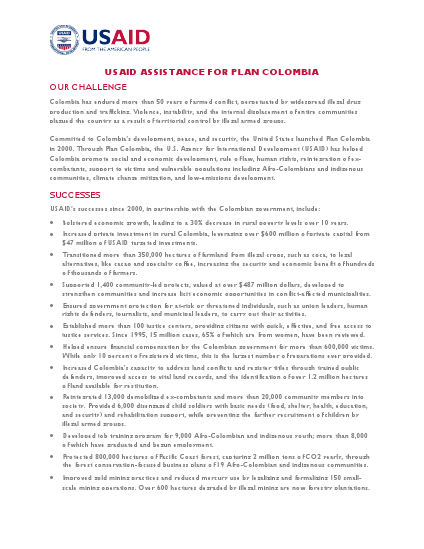Speeches Shim
OUR CHALLENGE
Colombia has endured more than 50 years of armed conflict, perpetuated by widespread illegal drug production and trafficking. Violence, instability, and the internal displacement of entire communities plagued the country as a result of territorial control by illegal armed groups.
USAID Assistance for Plan Colombia ![]() (pdf - 1 MB)
(pdf - 1 MB)
Committed to Colombia’s development, peace, and security, the United States launched Plan Colombia in 2000. Through Plan Colombia, the U.S. Agency for International Development (USAID) has helped Colombia promote social and economic development, rule of law, human rights, reintegration of ex-combatants, support to victims and vulnerable populations including Afro-Colombians and indigenous communities, climate change mitigation, and low-emissions development.
SUCCESSES
USAID’s successes since 2000, in partnership with the Colombian government, include:
- Bolstered economic growth, contributing to a 30% decrease in rural poverty levels over 10 years.
- Increased private investment in rural Colombia, leveraging over $600 million of private capital from $47 million of USAID targeted investments.
- Planted more than 350,000 hectares of farmland with licit crops, like cacao and specialty coffee, increasing the security and economic benefit of hundreds of thousands of farmers.
- Supported 1,400 community-led projects, valued at over $487 million dollars, developed to strengthen communities and increase licit economic opportunities in conflict-affected municipalities.
- Ensured government protection for at-risk or threatened individuals, such as union leaders, human rights defenders, journalists, and municipal leaders, to carry out their activities.
- Enabled the establishment of more than 100 justice centers, providing citizens with quick, effective, and free access to justice services. Since 1995, 15 million cases, 65% of which are from women, have been reviewed.
- Helped ensure financial compensation by the Colombian government for more than 600,000 victims. While only 10 percent of registered victims, this is the largest number of reparations ever provided.
- Increased Colombia’s capacity to address land conflicts and register titles through trained public defenders, improved access to vital land records, and the identification of over 1.2 million hectares of land available for restitution.
- Supported the reintegration of 13,000 demobilized ex-combatants and more than 20,000 community members into society. Provided 6,000 disengaged child soldiers with basic needs (food, shelter, health, education, and security) and rehabilitation support, while preventing the further recruitment of children by illegal armed groups.
- Developed job training program for 9,000 Afro-Colombian and indigenous youth; more than 8,000 of which have graduated and begun employment.
- Protected 800,000 hectares of Pacific Coast forest, capturing 2 million tons of CO2 yearly, through the forest conservation-focused business plans of 19 Afro-Colombian and indigenous communities.
- Improved gold mining practices and reduced mercury use by legalizing and formalizing 150 small scale mining operations. Over 600 hectares degraded by illegal mining are now forestry plantations.


Comment
Make a general inquiry or suggest an improvement.